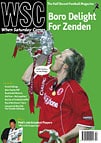 The once vibrant area of football comic publishing was at death's door through failing to keep up with the times, until Stuart Green's Glory Glory began to rival the long-serving Roy of the Rovers in the early Nineties. Frank Plowright discovers a new title in the football comic world
The once vibrant area of football comic publishing was at death's door through failing to keep up with the times, until Stuart Green's Glory Glory began to rival the long-serving Roy of the Rovers in the early Nineties. Frank Plowright discovers a new title in the football comic world
I once helped produce a football comic. It was the early 1990s and, as co-creator of the Teenage Mutant Ninja Turtles, Kevin Eastman’s income was stratospheric. A lifelong comic fan, he set up Tundra Publishing to finance and publish projects comic writers and artists had always wanted to produce, but which no established company would take on. It would later turn out that, in most cases, there were very good reasons.
Eastman also set up a Tundra UK. Impressed by the atmosphere as Chelsea beat Manchester United 3-2 in 1991, he backed a new weekly British football comic. Glory Glory was conceived by Stuart Green, who correctly reasoned that the once vibrant area of football comic publishing was at death’s door through failing to keep up with the times. In 1991 Roy of the Rovers was the sole weekly football comic available in the UK, constantly recycling the storylines that had seen Roy through the Fifties and Sixties. Stuart’s plan was a comic incorporating the irreverence of football fanzines and Viz with stories reaching far beyond scoring the winning goal in a vital cup tie. I was appointed joint editor.
The lead was a glamorous soap by a now regular EastEnders writer. There was a one-pager about moany old gits in the crowd, a Sunday morning team, a series of entitled Tales from the Dugout focusing on all aspects of the game and Stoppa, a steroid monster in defence. Best of all was Len Shackleswick, an ex-player turned self-obsessed alcoholic pundit, for whom no chance to earn a few bob was too tawdry. In distancing Glory Glory from its predecessors having a designer make the comic look like something published in 1992 was a priority and, pre-empting today’s Striker, we anticipated extra revenue from selling shirt sponsorship.
This would be something your average fan would enjoy as much as his son, so we planned to launch by selling outside grounds as well as in shops. So how come you’ve never seen Glory Glory? Well, the short version is that it all ended in tears. Money haemorrhaged at Tundra USA, where creators were happy to take large advances for work that was either never seen or lacked commercial appeal. Eastman later estimated Tundra lost him $14 million (£7.5m) and the accountants he’d appointed placed tighter and tighter restrictions on the UK office. Being a proposed weekly, Glory Glory was by far the biggest consumer of the Tundra UK budget and, with three months to go before launch in August 1992, the plug was pulled.
We touted the comic around and eventually Stuart took on the task of giving Roy of the Rovers a facelift. It was a creditable revamp, writing Roy out with an amputated leg and focusing on his son Rocky amid a multicultural cast that placed the strip firmly in the 1990s. With restrictions on the amount of new material to be commissioned, though, and no publicity budget, it sank after 19 monthly issues.
Among all the football titles launched in the 1990s, only one publisher considered comics, producing detailed club histories of Liverpool, Spurs and Newcastle. They were characterised by problematical likenesses throughout, static art obviously traced from photographs and the shocking cover price of £4.50 for 24 pages plus cover. DC Thomson even cancelled their long-running, but resolutely old-fashioned, Football Picture Monthly in 2003.
But now there’s Striker, formerly in the Sun, now a stand-alone title. It’s not for me but, while it may replace once set of cliches with another, at least it’s a comic offering a vision of the present-day or, taking Gazza into account, football of a vintage within recent memory and with 3-D computer graphics it also looks like it was produced in the 21st century.
From WSC 206 April 2004. What was happening this month